Several weeks ago, Hiroto (a pseudonym) received a phone call from a friend. The friend, who had met Hiroto for dinner a few days prior, plainly stated on the phone call that he had tested positive for COVID-19 recently and urged everyone he had met within a week to also get tested. Alarmed, Hiroto immediately began phoning clinics near his house to see if he could schedule a COVID test as soon as possible.
Hiroto’s situation is becoming more common, as Japan’s COVID-19 data shows the number of new infections in the country jumping by more than 1,000 every day for the past several weeks. However, with slightly under 400,000 cumulative cases and less than 6,000 deaths, Japan’s situation seems much better than those of Western countries. Cultural advantages, including the widespread use of masks and adherence to social distancing guidelines, may have suppressed COVID-19 infections and allowed daily lives to continue without the need for strict lockdowns.
Yet, Japan’s relatively rosy figures on COVID-19 are a reflection of several issues that illustrate the lack of transparency in government and public health authorities. In turn, those gaps mask the true scale of the pandemic in the country.
The first concerns the lack of PCR testing. Media outlets have questioned the low rate of COVID-19 testing in Japan, suggesting that the true number of infections would be much higher if the country acquired more testing capacity and conducted more tests. Indeed, the official website of Japan’s Ministry of Health, Labor, and Welfare (MHLW) states that the country has the capacity of processing only 141,147 tests per day and that in the year leading up to February 1, only 7.31 million tests were conducted, an average of 20,000 tests a day. Considering that Japan has more than 126 million people, for any person to access a test is not easy.
Hiroto’s experience is illustrative. He was able to secure an appointment with a private medical practice only after more than 20 other hospitals and clinics rejected his request for a test, citing lack of equipment or processing capability.
The lack of testing is further aggravated by a lack of timely communication. Instead of a central agency tasked with handling correspondence with people suspected and confirmed to have COVID-19, it has relied on a kaleidoscope of hotlines operated by the national and local governments, as well as private organizations. Many of the hotlines are manned by overworked staff. The majority of Kanagawa and Shizuoka prefectural government staff responsible for COVID-related work, for instance, have clocked in more than 80 hours in overtime per month, with some stating that they have done more than 150 hours.
The result of staff overwork is an inability to regularly check in with COVID-19 patients to ensure adherence to quarantine protocol. In Hiroto’s case, he only received a phone call a day after he tested positive for COVID-19 in a private practice and the doctor forwarded the information to local health authorities. In the phone call, a government worker simply instructed Hiroto to stay home and make sure to receive a daily phone call from the authorities to check on his situation. For the next two weeks, Hiroto received an automated government phone call every afternoon, going through the same list of questions about whether he had any symptoms or had come into contact with anyone that day.
Perhaps most gravely for Japan’s lack of transparency, a lack of contact tracing makes it difficult for health authorities to know who should be tested and contacted. While Taiwan, Singapore, and South Korea have been praised for aggressive contact tracing through the collection of digital data, Japan has not seen the same level of success. The MHLW’s COVID tracing app, COCOA, the only nationwide app promoted by the government, had only been downloaded 22 million times by January, representing a penetration rate of less than 18 percent. Trust in the app is low, with a rating of 2.8 out of five on Google Play Store, and the media reporting as recently as February 3 that bugs in the app are leading to users not being notified promptly.
The lack of government efforts to contact trace is particularly glaring in Hiroto’s case. Neither his friend nor he is a COCOA user, and they have not, at any point, provided information to any authorities on their known contacts. Had his friend not called him, Hiroto would have never known that he came into contact with a COVID-19 carrier. And on the 14th day after he tested positive, Hiroto received a phone call from another government worker. The worker stated that since he had no symptoms for two weeks, Hiroto was now free to go outside of his apartment. The worker did not schedule another test to confirm that Hiroto is now COVID-19 negative.
In a matter of two weeks, Hiroto went from being tallied as an “active” case to “discharged” on Japan’s COVID-19 statistics without ever having his infection confirmed by government authorities. While he is fortunate to have been asymptomatic throughout his experience, others may not have the same luck. Worst of all, because Hiroto was registered as “discharged” at the end of his quarantine, no contact tracing efforts have been expended on him since, meaning neither he nor government authorities will ever know who may have tested positive for COVID-19 because of him.
Analyses of governments around the world that most effectively suppressed COVID-19 conclude that best practices include widespread testing, aggressive contact tracing, and open public communication. The Japanese government follows none of these best practices. While Japan is fortunate that its current levels of COVID-19 infections have remained relatively manageable, if what Hiroto went through is the standard practice, the overall situation cannot be considered optimistic.
Xiaochen Su is a Ph.D. candidate at the University of Tokyo specializing in immigration issues. He previously worked in East Africa, Taiwan, South Korea, and Southeast Asia.

































